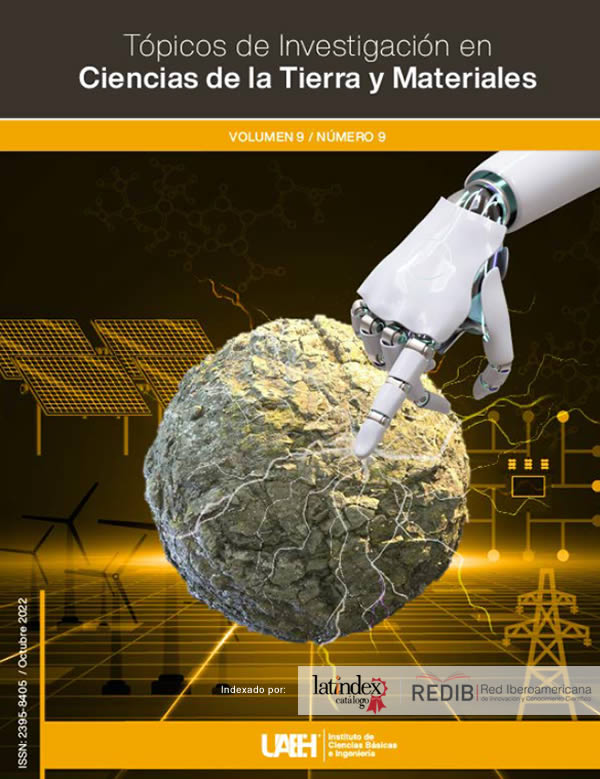Evaluation of the Tulancingo Valley Aquifer for irrigation purposes
Abstract
The evaluation of the Valle de Tulancingo aquifer has allowed to identify that the main hydrochemical facies in the system correspond to Na-K-HCO3- and Ca-Mg-HCO3-, characteristics of systems with relatively short residence times. The salinity parameters such as the sodium adsorption ratio (SAR) are in the range between 0.783 and 1.912; the %Na between 33.105 and 67.635, the residual sodium carbonate (CSR) observed values between -1.224 and 0.983, while the potential salinity (SP) presented a minimum value of 0.397 and a maximum value of 2.954. In addition, the permeability index (PI) values are between 65.325 and 141.128, varying the Kelly ratio (RK) from 0.405 to 1.686 and the risk of magnesium (MH) between 33.415 and 39.867. According to the different evaluation criteria of water for irrigation purposes, it is suitable for it, and its quality is classified from good to excellent.
Downloads
References
American Public Health Association, (1999). Standard methods for the examination of water and wastewater. 20th Ed. APHA, AWWA, WEF. 1- 45.
Assaha, D. V. M., Ueda, A., Saneoka, H., Al-Yahyai, R., Yaish, M. W., (2017). The role of Na+ and K+ transporters in salt stress adaptation in glycophytes. Front. Physiol. 8 (509). 1-19.
DOI: 10.3389/fphys.2017.00509
Comisión Nacional del Agua, (2018a). Actualización de la disponibilidad media anual de agua en el acuífero del Valle de Tulancingo (1317), Estado de Hidalgo. Publicado en el Diario Oficial de la Federación en enero de 2018. Recuperado el 15 de Febrero de 2022 de: https://www.gob.mx/cms/uploads/attachment/file/10 3066/DR_1317.pdf
Comisión Nacional del Agua, (2018b). Estadísticas del Agua en México. Edición 2018. Secretaria del Medio Ambiente y Recursos Naturales, México. Recuperado el 2 de marzo de 2022 en https://sina.conagua.gob.mx/publicaciones/EAM_2018.pdf
Comisión Nacional del Agua, (2019). Estadísticas del agua en México 2019. Secretaria del Medio Ambiente y Recursos Naturales, México. Recuperado el 6 de marzo de 2022 en http://sina.conagua.gob.mx/publicaciones/EAM_2019.pdf
Comisión Nacional del Agua, (2020a). Actualización de la disponibilidad media anual de agua en el acuífero Valle de Tulancingo (1317), Estado de Hidalgo. Subdirección General Técnica, Gerencia de Aguas Subterráneas. Recuperado el 21 de abril del 2022 en https://sigagis.conagua.gob.mx/gas1/Edos_Acuiferos_18/hidalgo/DR_1317.pdf
Comisión Nacional del Agua, (2020b). Actualización de la disponibilidad media anual de agua en el Acuífero Tepeji del Río (1316), Estado de Hidalgo. Subdirección General Técnica, Gerencia de Aguas Subterráneas. Recuperado el 21 de abril de 2022 en https://sigagis.conagua.gob.mx/gas1/Edos_Acuiferos_18/hidalgo/DR_1316.pdf
Chadha, D. K., (1999). A proposed new diagram for geochemical classification of natural waters and interpretation of chemical data. Hydrogeol. J. 7, 431-439.
Doneen, L. D., (1962). The influence of crop and soil on percolating water. Proc. 1961 Biennial Conference on Groundwater Recharge. 156-163.
Drever, J. I., (1997). The geochemistry of natural waters: surface and groundwater environments (3rd Edition). Prentice-Hall, New Jersey USA.
Griffioen, J., (2004). Groundwater quality. In: V.S. Kovalevsky, G.P. Kruseman, & K.R. Rushton (Eds.), Groundwater studies: an international guide for hydrogeological investigations. IHP-VI, Series on groundwater No. 3. UNESCO, Paris, Ch. 2, pp. 43-65.
Instituto Nacional de Estadística, Geografía e Informática, (2021). Censos y conteos de población y vivienda 2020. Consultado el 13 de marzo de 2022 en https://www.inegi.org.mx/programas/ccpv/2020/
Kelly, W. P., (1940). Permissible composition and concentration of irrigated waters. Proc. Am. Soc. Civ. Eng, 66, 607-613.
Lesser, I. J. M., Arellano, I. S., González, P. D., Lesser, C .L. E., (2006). Balance y modelo del acuífero del Valle de Tulancingo. Resumen ejecutivo. Recuperado el 20 de Abril de 2022 en http://www.lesser.com.mx/files/07.1- Tulancingo_ Lesser.pdf
Li, P., Wu, J., Qian, H., (2014). Hydrogeochemistry and quality assessment of shallow groundwater in the southern part of the Yellow River alluvian plain (Zhongwei Section), Northwest China. Earth. Sci. Res. J. 18 (1), 27-38.
Lloyd, J. W., Heathcote, J. A., (1985). Natural inorganic hydrochemistry in relation to groundwater: an introduction (1st Ed.). Clarendon, USA.
Naciones Unidas, (2018). La Agenda 2030 y los Objetivos de Desarrollo Sostenible: una oportunidad para América Latina y el Caribe (LC/G.2681-P/Rev.3), Santiago. Recuperado el 11 de abril de 2022 en https://repositorio.cepal.org/bitstream/handle/11362/40155/24/S1801141_es.pdf
Orosco-Alcalá, B. E., Núñez-Palenius, H. G., Pérez-Moreno, L., Valencia-Posadas, M., Trejo-Téllez, L. I., Díaz-Serrano, F. R., Ruíz-Nieto, J. E., Abraham-Juárez, M. R., (2018). Tolerancia a la salinidad en plantas cultivadas: una visión agronómica. Agroproductividad 11 (7), 51-57.
Parkhurst, D. L., Appelo, C. A. J., (1999). User´s guide to PHREEQC (ver. 2): A computer program for speciation, batch reaction, one dimensional transport, and inverse geochemical calculations. USGS Water Resources Investigation Report 99, 4259.
Rawat, K. S., Singh, S. K., Gautam, S. K., (2018). Assessment of groundwater quality for irrigation use: a peninsular case study. Appl. Water Sci. 8(8), 1-24.
DOI: 10.1007/s13201-018-0866-8
Richards, L. A., (1968). Diagnosis and improvement of saline and alkali soils. Agriculture handbook 60, 210-220.
Rodier, J., Legube, B., Merlet, N., (1998). Análisis del agua. Ediciones Omega, Barcelona.
Sadzawka, R.A., (2006). Métodos de análisis de aguas para riego. Serie Actas INIA No. 37. Instituto de Investigaciones Agropecuarias.
Servicio de Información Agroalimentaria y Pesquera, (2021). Estadística de Producción Agrícola 2010-2020. Consultado el 21 de marzo de 2022 en http://infosiap.siap.gob.mx/gobmx/datosAbiertos.php
Szabolcs, I., (1964). The influence of irrigation water of high sodium carbonate content on soils. Agrokémia és talajtan, I3 (sup), 237-246.
USSL, (1954). Classification of irrigation waters. US Department of Agriculture, Circu 969. Washington.
Wilcox, L. V. (1948). The quality of water for irrigation use. US Dept. of Agriculture, Tech. Bull. 962, Washington, D.C.
Copyright (c) 2022 Misael Cruz-Sánchez, Violeta Lobaco-Mejía, Carlos Esquivel-Macías, Marius Ramírez-Cardona, Kinardo Flores-Castro

This work is licensed under a Creative Commons Attribution-NonCommercial-NoDerivatives 4.0 International License.












